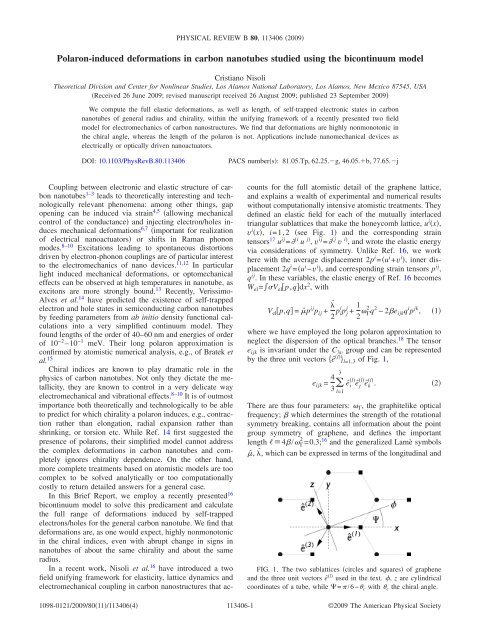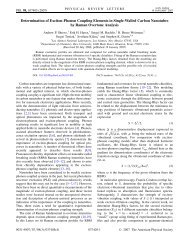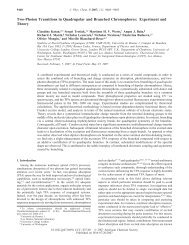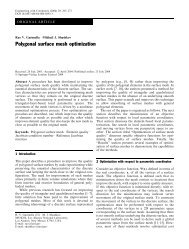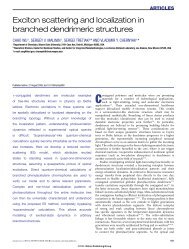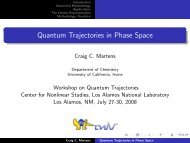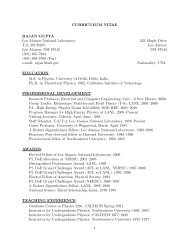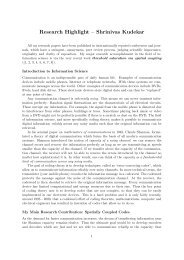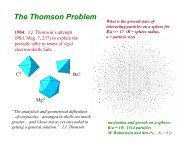Polaron-induced deformations in carbon nanotubes - Center for ...
Polaron-induced deformations in carbon nanotubes - Center for ...
Polaron-induced deformations in carbon nanotubes - Center for ...
Create successful ePaper yourself
Turn your PDF publications into a flip-book with our unique Google optimized e-Paper software.
<strong>Polaron</strong>-<strong><strong>in</strong>duced</strong> <strong>de<strong>for</strong>mations</strong> <strong>in</strong> <strong>carbon</strong> <strong>nanotubes</strong> studied us<strong>in</strong>g the bicont<strong>in</strong>uum model<br />
Cristiano Nisoli<br />
Theoretical Division and <strong>Center</strong> <strong>for</strong> Nonl<strong>in</strong>ear Studies, Los Alamos National Laboratory, Los Alamos, New Mexico 87545, USA<br />
Received 26 June 2009; revised manuscript received 26 August 2009; published 23 September 2009<br />
We compute the full elastic <strong>de<strong>for</strong>mations</strong>, as well as length, of self-trapped electronic states <strong>in</strong> <strong>carbon</strong><br />
<strong>nanotubes</strong> of general radius and chirality, with<strong>in</strong> the unify<strong>in</strong>g framework of a recently presented two field<br />
model <strong>for</strong> electromechanics of <strong>carbon</strong> nanostructures. We f<strong>in</strong>d that <strong>de<strong>for</strong>mations</strong> are highly nonmonotonic <strong>in</strong><br />
the chiral angle, whereas the length of the polaron is not. Applications <strong>in</strong>clude nanomechanical devices as<br />
electrically or optically driven nanoactuators.<br />
DOI: 10.1103/PhysRevB.80.113406 PACS numbers: 81.05.Tp, 62.25.g, 46.05.b, 77.65.j<br />
Coupl<strong>in</strong>g between electronic and elastic structure of <strong>carbon</strong><br />
<strong>nanotubes</strong> 1–3 leads to theoretically <strong>in</strong>terest<strong>in</strong>g and technologically<br />
relevant phenomena: among other th<strong>in</strong>gs, gap<br />
open<strong>in</strong>g can be <strong><strong>in</strong>duced</strong> via stra<strong>in</strong> 4,5 allow<strong>in</strong>g mechanical<br />
control of the conductance and <strong>in</strong>ject<strong>in</strong>g electron/holes <strong>in</strong>duces<br />
mechanical <strong>de<strong>for</strong>mations</strong> 6,7 important <strong>for</strong> realization<br />
of electrical nanoactuators or shifts <strong>in</strong> Raman phonon<br />
modes. 8–10 Excitations lead<strong>in</strong>g to spontaneous distortions<br />
driven by electron-phonon coupl<strong>in</strong>gs are of particular <strong>in</strong>terest<br />
to the electromechanics of nano devices. 11,12 In particular<br />
light <strong><strong>in</strong>duced</strong> mechanical <strong>de<strong>for</strong>mations</strong>, or optomechanical<br />
effects can be observed at high temperatures <strong>in</strong> nanotube, as<br />
excitons are more strongly bound. 13 Recently, Verissimo-<br />
Alves et al. 14 have predicted the existence of self-trapped<br />
electron and hole states <strong>in</strong> semiconduct<strong>in</strong>g <strong>carbon</strong> <strong>nanotubes</strong><br />
by feed<strong>in</strong>g parameters from ab <strong>in</strong>itio density functional calculations<br />
<strong>in</strong>to a very simplified cont<strong>in</strong>uum model. They<br />
found lengths of the order of 40–60 nm and energies of order<br />
of 10 −2 –10 −1 meV. Their long polaron approximation is<br />
confirmed by atomistic numerical analysis, e.g., of Bratek et<br />
al. 15<br />
Chiral <strong>in</strong>dices are known to play dramatic role <strong>in</strong> the<br />
physics of <strong>carbon</strong> <strong>nanotubes</strong>. Not only they dictate the metallicity,<br />
they are known to control <strong>in</strong> a very delicate way<br />
electromechanical and vibrational effects. 8–10 It is of outmost<br />
importance both theoretically and technologically to be able<br />
to predict <strong>for</strong> which chirality a polaron <strong>in</strong>duces, e.g., contraction<br />
rather than elongation, radial expansion rather than<br />
shr<strong>in</strong>k<strong>in</strong>g, or torsion etc. While Ref. 14 first suggested the<br />
presence of polarons, their simplified model cannot address<br />
the complex <strong>de<strong>for</strong>mations</strong> <strong>in</strong> <strong>carbon</strong> <strong>nanotubes</strong> and completely<br />
ignores chirality dependence. On the other hand,<br />
more complete treatments based on atomistic models are too<br />
complex to be solved analytically or too computationally<br />
costly to return detailed answers <strong>for</strong> a general case.<br />
In this Brief Report, we employ a recently presented 16<br />
bicont<strong>in</strong>uum model to solve this predicament and calculate<br />
the full range of <strong>de<strong>for</strong>mations</strong> <strong><strong>in</strong>duced</strong> by self-trapped<br />
electrons/holes <strong>for</strong> the general <strong>carbon</strong> nanotube. We f<strong>in</strong>d that<br />
<strong>de<strong>for</strong>mations</strong> are, as one would expect, highly nonmonotonic<br />
<strong>in</strong> the chiral <strong>in</strong>dices, even with abrupt change <strong>in</strong> signs <strong>in</strong><br />
<strong>nanotubes</strong> of about the same chirality and about the same<br />
radius.<br />
In a recent work, Nisoli et al. 16 have <strong>in</strong>troduced a two<br />
field unify<strong>in</strong>g framework <strong>for</strong> elasticity, lattice dynamics and<br />
electromechanical coupl<strong>in</strong>g <strong>in</strong> <strong>carbon</strong> nanostructures that ac-<br />
PHYSICAL REVIEW B 80, 113406 2009<br />
counts <strong>for</strong> the full atomistic detail of the graphene lattice,<br />
and expla<strong>in</strong>s a wealth of experimental and numerical results<br />
without computationally <strong>in</strong>tensive atomistic treatments. They<br />
def<strong>in</strong>ed an elastic field <strong>for</strong> each of the mutually <strong>in</strong>terlaced<br />
triangular sublattices that make the honeycomb lattice, u i x,<br />
v i x, i=1,2 see Fig. 1 and the correspond<strong>in</strong>g stra<strong>in</strong><br />
tensors 17 u ij = i u j , v ij = j v i , and wrote the elastic energy<br />
via considerations of symmetry. Unlike Ref. 16, we work<br />
here with the average displacement 2p i =u i +v i , <strong>in</strong>ner displacement<br />
2q i =u i −v i , and correspond<strong>in</strong>g stra<strong>in</strong> tensors p ij ,<br />
q ij . In these variables, the elastic energy of Ref. 16 becomes<br />
W el=V elp,qdx 2 , with<br />
Velp,q = ˆ pijpij + ˆ<br />
2 pi i j 1<br />
pj +<br />
2 2 2<br />
q<br />
−2eijkqipjk , 1<br />
where we have employed the long polaron approximation to<br />
neglect the dispersion of the optical branches. 18 The tensor<br />
e ijk is <strong>in</strong>variant under the C 3v group and can be represented<br />
by the three unit vectors ê l l=1,3 of Fig. 1,<br />
eijk = 4<br />
3 3<br />
l l l<br />
êi êj êk . 2<br />
l=1<br />
There are thus four parameters: , the graphitelike optical<br />
frequency; which determ<strong>in</strong>es the strength of the rotational<br />
symmetry break<strong>in</strong>g, conta<strong>in</strong>s all <strong>in</strong><strong>for</strong>mation about the po<strong>in</strong>t<br />
group symmetry of graphene, and def<strong>in</strong>es the important<br />
2<br />
length 4/ =0.3;<br />
16 and the generalized Lamè symbols<br />
ˆ , ˆ , which can be expressed <strong>in</strong> terms of the longitud<strong>in</strong>al and<br />
FIG. 1. The two sublattices circles and squares of graphene<br />
and the three unit vectors ê l used <strong>in</strong> the text. , z are cyl<strong>in</strong>drical<br />
coord<strong>in</strong>ates of a tube, while =/6− c with c the chiral angle.<br />
1098-0121/2009/8011/1134064 113406-1<br />
©2009 The American Physical Society
BRIEF REPORTS PHYSICAL REVIEW B 80, 113406 2009<br />
2<br />
transverse speed of sound <strong>in</strong> graphene, vL=2ˆ +ˆ 2 2<br />
−4 /,<br />
2 2 2<br />
vT=ˆ −4 /,<br />
and are related to the actual Lamè symbols<br />
of graphene r, r via r=ˆ −42 2<br />
/ and r=ˆ +42 2<br />
/. We then write p <strong>in</strong> term of the isotropic o, anisotropic ,<br />
and shear/torsional stra<strong>in</strong> <strong>in</strong> the nanotube coord<strong>in</strong>ates<br />
p = o + ,<br />
p zz = o − . 3<br />
pz = pz = .<br />
In these new variables the elastic energy Eq. 1 now reads<br />
Vel =2ˆ 2 2 2 2 1<br />
o +2ˆ o + + +<br />
2 2 2 <br />
q<br />
−4q s3 − c3 +4q z c 3 + s 3. 4<br />
We have shortened c3cos3c, s3s<strong>in</strong>3c, c is the chiral<br />
angle of the nanotube, and used e,,=−e,z,z=−s3, and<br />
ez,z,z=−e,,z=−c3. As expla<strong>in</strong>ed <strong>in</strong> Ref. 16, one can simply “wrap around”<br />
the elastic energy of graphene to deal with <strong>carbon</strong> <strong>nanotubes</strong>.<br />
In the cyl<strong>in</strong>drical geometry, with coord<strong>in</strong>ates r,,z of Fig.<br />
1, a m<strong>in</strong>imal coupl<strong>in</strong>g between the tangential displacements<br />
pi and the radial pr appears <strong>in</strong> Vel of Eq. 1 via p =p + pr/r. 17 As expla<strong>in</strong>ed, we assume no azimuthal dependence,<br />
and thus 2o= zpz+ pr/r, 2=−zpz+ pr/r, 2= zp. We are neglect<strong>in</strong>g the break<strong>in</strong>g of the hexagonal<br />
symmetry brought upon by the chiral vector that def<strong>in</strong>es the<br />
wrapp<strong>in</strong>g of the <strong>carbon</strong> nanotube. This symmetry break<strong>in</strong>g<br />
allows <strong>for</strong> additional terms <strong>in</strong> Vel as curvature corrections.<br />
The parameters of our elastic energy <strong>for</strong> graphene are also<br />
corrected by curvature.<br />
As <strong>for</strong> the low-energy electronic excitations <strong>in</strong> a semiconduct<strong>in</strong>g<br />
nanotube, they can be described <strong>in</strong> terms of an envelope<br />
wave-function Ref. 19 of energy density<br />
Ee,p,q =− †2 2<br />
z 2m + Eep,p,q. 5<br />
E ep, the coupl<strong>in</strong>g between phonons and an <strong>in</strong>jected electron<br />
or hole, at lowest order both <strong>in</strong> the <strong>in</strong> plane elastic fields and<br />
<strong>in</strong> the electron probability density 2 can be deduced via<br />
considerations of symmetry<br />
E ep = 2 q z /e + c 3 + s 3 + o 6<br />
e is the bond length. Physically, the term proportional to <br />
emerges <strong>in</strong> dielectric tubes from a de<strong>for</strong>mation-<strong><strong>in</strong>duced</strong><br />
change <strong>in</strong> the bandgap, whereas the term proportional to <br />
comes from the shift <strong>in</strong> energy at the K po<strong>in</strong>t of the Brillou<strong>in</strong><br />
zone due to second-nearest-neighbor atoms. 6 In the context<br />
of a simple tight-b<strong>in</strong>d<strong>in</strong>g treatment, 2 hopp<strong>in</strong>g <strong>in</strong>tegrals are<br />
modulated by <strong>in</strong> plane elastic <strong>de<strong>for</strong>mations</strong>: 16 dtl =<br />
l l ij<br />
êj p +êi<br />
l i −êi q /e are the three nearest-neighbor hopp<strong>in</strong>g<br />
<strong>in</strong>tegrals along the three bonds of unit vectors êl , whereas<br />
l l ij<br />
âj p are the hopp<strong>in</strong>g <strong>in</strong>tegrals along the three<br />
dtl =−âi directions âl of the next-nearest neighbors. , are often<br />
called scal<strong>in</strong>g parameters. 20 Follow<strong>in</strong>g along the l<strong>in</strong>e of<br />
Refs. 5 and 16, one can calculate the variation <strong>in</strong> the band<br />
113406-2<br />
gap and of the energy at the K po<strong>in</strong>t under stra<strong>in</strong> via hopp<strong>in</strong>g<br />
<strong>in</strong>tegral modulation, and—after long yet not particularly <strong>in</strong>sightful<br />
calculations—deduce Eq. 6 and <strong>in</strong> particular<br />
= 3,<br />
= 3<br />
2 s p.<br />
The m<strong>in</strong>us sign <strong>in</strong> the first equation is <strong>for</strong> electrons, the plus<br />
<strong>for</strong> holes. Note that there is no change <strong>in</strong> sign <strong>for</strong> <strong>in</strong> go<strong>in</strong>g<br />
from holes to electrons. The other sign function is s1=−1 s2=1 where p is def<strong>in</strong>ed as a function of n, m as pn<br />
−mmod 3. This difference <strong>in</strong> sign behavior between and<br />
was previously recognized as caus<strong>in</strong>g <strong>in</strong>dices dependence<br />
and nonmonotonicity <strong>in</strong> the dop<strong>in</strong>g-<strong><strong>in</strong>duced</strong> shift of Raman<br />
frequencies and anomalous bond contraction/expansion <strong>in</strong><br />
zigzag <strong>nanotubes</strong>. 8–10,16 We will see that it controls chirality<br />
dependent expansions vs contractions <strong>for</strong> hole or electron<br />
self-trapp<strong>in</strong>g.<br />
We assume that our fields only vary along the axial coord<strong>in</strong>ate<br />
z, an ansatz corroborated by previous numerical calculations,<br />
as expla<strong>in</strong>ed above. 15 This treatment—we will<br />
see—is self-consistent as it predicts very long polarons. The<br />
Hamiltonian density <strong>for</strong> the entire system is then<br />
H =− †2 2<br />
z 2m + cVel + Eep 8<br />
where V el is given by Eq. 4, E ep is given by Eq. 6, and<br />
c=2r is the nanotube circumference. M<strong>in</strong>imization under<br />
normalization of with Lagrangia multiplier p returns the<br />
system of equations of equilibrium <strong>for</strong> our system,<br />
4ˆ + ˆ o =− 2 /c,<br />
4ˆ −4q s 3 − q zc 3 =−c 3 2 /c,<br />
4ˆ +4q c 3 + q zs 3 =−s 3 2 /c,<br />
2<br />
4c3 + s3 + qz =−2 /ec,<br />
− 2<br />
p =<br />
2m z 2<br />
4s3 − c3 − q =0,<br />
2 + q z /e + c3 + s 3 + o<br />
which is l<strong>in</strong>ear <strong>in</strong> the elastic fields and can be solved easily<br />
<strong>for</strong> them <strong>in</strong> terms of 2 .<br />
We f<strong>in</strong>d <strong>for</strong> the local de<strong>for</strong>mation <strong><strong>in</strong>duced</strong> by an <strong>in</strong>jected<br />
electron or hole the equations<br />
o = o 2 ,<br />
7<br />
9<br />
=−s p cos3 c 2 , 10<br />
=−s p s<strong>in</strong>3 c 2 ,<br />
which show that stra<strong>in</strong> is higher <strong>in</strong> regions where the electron<br />
is localized. We f<strong>in</strong>d o= 3<br />
<strong>in</strong>versely<br />
4cv2 L−vT 2 , =<br />
31+l/e<br />
8cv2 T
BRIEF REPORTS PHYSICAL REVIEW B 80, 113406 2009<br />
proportional to the circumference. The sign <strong>in</strong> the first equation<br />
of 10 is plus <strong>for</strong> electrons and m<strong>in</strong>us <strong>for</strong> holes. The<br />
other two equations change sign depend<strong>in</strong>g on the chirality<br />
of the nanotube via s p.<br />
From Eq. 3 we have <strong>for</strong> the total elongation and torsion<br />
of the tube L= o−dz and r=dz, and thus from<br />
Eq. 10 and because of normalization of , we obta<strong>in</strong><br />
L = o + sp cos3c 11<br />
r =−sp s<strong>in</strong>3c, where, repetita juvant, the sign <strong>in</strong> the first equation is plus<br />
<strong>for</strong> electrons and m<strong>in</strong>us <strong>for</strong> holes. Note that the overall elongation<br />
and torsion of the tube due to electron/hole <strong>in</strong>jection<br />
is <strong>in</strong>dependent of the actual shape of . Un<strong>for</strong>tunately, that<br />
also implies that self-trapped electronic excitations cannot be<br />
recognized by global observations such has overall elongation,<br />
but solely via local mechanical features.<br />
Equation 11 generalize to arbitrary chirality what already<br />
found by Nisoli et al. 16 <strong>for</strong> dop<strong>in</strong>g of zigzag <strong>nanotubes</strong>.<br />
The first result from Eq. 11 is that electron/hole <strong>in</strong>jection<br />
<strong>in</strong>duces no torsion <strong>for</strong> zigzag <strong>nanotubes</strong> which<br />
correspond to m=0, thus c=0, at least <strong>in</strong> our approximation<br />
that neglects curvature corrections. On the other hand,<br />
torsion would be maximum <strong>for</strong> tubes approach<strong>in</strong>g the armchair<br />
configuration the armchair themselves are metallic and<br />
thus excluded from this study: that would be n=m+1. Aga<strong>in</strong><br />
from Eq. 11 we obta<strong>in</strong> that elongation is always positive <strong>for</strong><br />
electrons <strong>in</strong> <strong>nanotubes</strong> with p=2, whereas is always negative<br />
<strong>for</strong> holes <strong>in</strong> <strong>nanotubes</strong> with p=1. The maximum <strong>in</strong> both<br />
cases is achieved by zigzag <strong>nanotubes</strong> c=0. These results<br />
are <strong>in</strong> agreement with the density-functional study of Ref.<br />
14, who found elongation <strong>for</strong> electrons <strong>in</strong> 11,0 zigzag, and<br />
contraction <strong>for</strong> holes <strong>in</strong> 7,0 zigzag.<br />
Analysis of the general case requires knowledge of the<br />
quantities o, . Ifo, the first equation of Eq. 11 tells as<br />
that chirality can change the sign of L and thus predicts<br />
shorten<strong>in</strong>g <strong>for</strong> self-trapped electrons, yet elongation <strong>for</strong><br />
holes, <strong>in</strong> certa<strong>in</strong> tubes. This seems to be the case, from a<br />
rough estimate: we use e=1.42 Å and the Harrison scal<strong>in</strong>g<br />
<strong>for</strong> the hopp<strong>in</strong>g parameters, 20 which are =2t, =2t, with<br />
t2.8 eV, t0.68 eV. 21 For the speeds of sound <strong>in</strong><br />
graphene we use vT=1.4104 m s−1 , vL=2.16104 ms−1 as <strong>in</strong><br />
Mahan; 16 f<strong>in</strong>ally from the density of graphite 2.26 gm cm−3 and the <strong>in</strong>terlayer distance at 3.4 Å the surface density of<br />
graphene can be estimated 7.610−7 Kg m−2 . We obta<strong>in</strong><br />
o2.510−2 Å2 /2r, 8.710−2 Å2 /2r. For a larger nanotube<br />
of 1 nm <strong>in</strong> diameter, 103 electrons can give a1nm<br />
elongation. S<strong>in</strong>ce the elongation and torsion are <strong>in</strong>versely<br />
proportional to the radius of the nanotube: these effects become<br />
stronger <strong>for</strong> small radii, <strong>for</strong> which our treatment is only<br />
a first order approximation.<br />
From Eq. 9 we f<strong>in</strong>d the <strong>in</strong>ner displacement<br />
q =0<br />
q z =−s pl + l 2 ,<br />
12<br />
113406-3<br />
2 2<br />
with l=4vT/e+l0.35 Å computed from vT<br />
=1.4104 ms−1 and =31014 s−1. Thus, the <strong>in</strong>ner displacement<br />
is always parallel to the nanotube axis, while its absolute<br />
magnitude is <strong>in</strong>dependent of the chiral angle. On the<br />
other hand, its orientation depends on the chiral <strong>in</strong>dices, thus<br />
suggest<strong>in</strong>g that polarons can <strong>in</strong>duce highly nonmonotonic<br />
anomalous bond contractions/expansion and thus harden<strong>in</strong>g/<br />
soften<strong>in</strong>g of optical modes. 8–10,16<br />
F<strong>in</strong>ally, by substitut<strong>in</strong>g the expression <strong>for</strong> the elastic fields<br />
Eqs. 10 and 12 <strong>in</strong>to the last equation of Eq. 9, one f<strong>in</strong>ds<br />
a nonl<strong>in</strong>ear Schröd<strong>in</strong>ger equation <strong>for</strong> the envelope <br />
p =− 2<br />
2m 2 2<br />
z<br />
+4 13<br />
<strong>in</strong> which the reciprocal length is found to be<br />
e = <br />
4c 2 t<br />
2e + le + l + l<br />
2 2<br />
vTe +<br />
4ˆ + ˆ 14 <br />
where we have used the expression m=22 /9ect <strong>for</strong> the<br />
effective mass of the electron obta<strong>in</strong>ed from the <strong>for</strong>mula <strong>for</strong><br />
the band gap. 2 The well-known self-bound solution of Eq.<br />
13<br />
z,t = <br />
2 cosh−1ze−i pt/ 15<br />
corresponds to a polaron of energy p=− 22 2m and length a<br />
=−1 . Remarkably unlike the amplitude of the elastic <strong>de<strong>for</strong>mations</strong>,<br />
the length and thus the energy of the polaron does<br />
not depend on the chiral angle. Also polaron length is the<br />
same <strong>for</strong> electrons and holes. This latter statement is <strong>in</strong> contrast<br />
with results reported by Verissimo-Alves: 14 while <strong>for</strong><br />
the 11,0 nanotube they f<strong>in</strong>d about the same polaron length<br />
<strong>for</strong> electron 39 nm and hole 40 nm, <strong>for</strong> the 7,0 case the<br />
electron polaron has a length of 59 nm, while the hole is 21<br />
nm long. We suspect that the discrepancy orig<strong>in</strong>ates from a<br />
sign error <strong>in</strong> the quantity which Ref. 14 def<strong>in</strong>es as z,as analysis of their Fig. 2 confirms. In our <strong>for</strong>malism and us<strong>in</strong>g<br />
the Harrison scal<strong>in</strong>g and parameters above, we have <strong>for</strong> a<br />
zigzag nanotube z=−3spt/23t and estimate z= −6.3 eV <strong>for</strong> electrons, −2.2 eV <strong>for</strong> holes, <strong>for</strong> a 10,0<br />
nanotube—<strong>in</strong> the ballpark with the Ref. 14 values of −8.3,<br />
−2.4 eV. Instead we f<strong>in</strong>d a sign mismatch <strong>for</strong> the 7,0<br />
where our estimates are +2.2 eV <strong>for</strong> electrons, +6.3 eV <strong>for</strong><br />
holes, whereas they have −1.6 eV, +7.8 eV. The polaron<br />
length a= −1 can be estimated from Eq. 14 to be of several<br />
hundred angstroms <strong>for</strong> <strong>nanotubes</strong> of a few nanometers <strong>in</strong><br />
diameter, <strong>in</strong> agreement with estimate based on density functional<br />
theory results. 14<br />
F<strong>in</strong>ally, <strong>for</strong> completeness, we calculate the radial variation<br />
<strong>in</strong> the nanotube r/r= p . From Eqs. 10 and 15 we see<br />
that the maximum radial variation corresponds to the maximum<br />
of at z=0 or<br />
r<br />
r = o 2a − s <br />
p<br />
2a cos3c, 16<br />
positive sign <strong>for</strong> electrons, negative <strong>for</strong> holes. There is always<br />
a radial shr<strong>in</strong>k<strong>in</strong>g <strong>in</strong> correspondence of self-trapped<br />
2
BRIEF REPORTS PHYSICAL REVIEW B 80, 113406 2009<br />
holes <strong>in</strong> <strong>nanotubes</strong> with p=2, and radial expansion <strong>for</strong> electrons<br />
<strong>in</strong> <strong>nanotubes</strong> with p=1, as partially confirmed by<br />
density-functional f<strong>in</strong>d<strong>in</strong>gs of Ref. 14.<br />
While the casuistic of excitons is too rich to be dealt with<br />
here, 13 we can still offer a few considerations <strong>for</strong> the E 11<br />
case. As coupl<strong>in</strong>gs of electron and holes with anisotropic<br />
<strong>de<strong>for</strong>mations</strong> o cancel each other, we must take =0 and<br />
thus o=0 <strong>in</strong> our equations. Hence, we can have optomechanical<br />
effects of both elongation or contraction, depend<strong>in</strong>g<br />
on the chiral <strong>in</strong>dices, as predicted by Eq. 11 with o<br />
=0.<br />
The treatment above applies to static polarons <strong>in</strong> not too<br />
small <strong>nanotubes</strong>, as we neglect the break<strong>in</strong>g of honeycomb<br />
symmetry brought up by the chiral vector. That would <strong>in</strong>troduce<br />
additional terms <strong>in</strong> the elastic energy <strong>in</strong> the <strong>for</strong>m of<br />
curvature corrections <strong>for</strong> very small radii. 16 Also, <strong>for</strong> small<br />
radii, orbital hybridization imposes a more sophisticate tightb<strong>in</strong>d<strong>in</strong>g<br />
treatment. For the propagat<strong>in</strong>g polaron, another symmetry<br />
break<strong>in</strong>g comes from the velocity vector, directed<br />
along the nanotube axis. Even <strong>for</strong> large <strong>nanotubes</strong>, we ex-<br />
1S. Iijima, Nature London 354, 561991.<br />
2R. Saito, G. Dresselhaus, and M. S. Dresselhaus, Physical Properties<br />
of Carbon Nanotubes Imperial College Press, London,<br />
1998.<br />
3M. S. Dresselhaus, G. Dresselhaus, and P. C. Eklund, Science of<br />
Fullerences and Carbon Nanotubes Academic, New York,<br />
1996.<br />
4A. Roche<strong>for</strong>t, P. Avouris, F. Lesage, and D. R. Salahub, Phys.<br />
Rev. B 60, 13824 1999.<br />
5L. Yang and J. Han, Phys. Rev. Lett. 85, 154 2000.<br />
6M. Verissimo-Alves, B. Koiller, H. Chacham, and R. B. Capaz,<br />
Phys. Rev. B 67, 161401R 2003.<br />
7Y. N. Gartste<strong>in</strong>, A. A. Zakhidov, and R. H. Baughman, Phys.<br />
Rev. B 68, 115415 2003.<br />
8E. R. Marg<strong>in</strong>e, P. E. Lammert, and V. H. Crespi, Phys. Rev. Lett.<br />
99, 196803 2007.<br />
9G. Chen, C. A. Furtado, U. J. Kim, and P. C. Eklund, Phys. Rev.<br />
B 72, 155406 2005.<br />
10G. Chen, C. A. Furtado, S. Bandow, S. Iijima, and P. C. Eklund,<br />
Phys. Rev. B 71, 045408 2005.<br />
11P. E. Lammert, P. Zhang, and V. H. Crespi, Phys. Rev. Lett. 84,<br />
2453 2000.<br />
12C. C. Chamon, Phys. Rev. B 62, 2806 2000.<br />
13M. S. Dresselhaus, G. Dresselhaus, R. Saito, and A. Jorio, Annu.<br />
Rev. Phys. Chem. 58, 719 2007.<br />
14M. Verissimo-Alves, R. B. Capaz, B. Koiller, E. Artacho, and H.<br />
Chacham, Phys. Rev. Lett. 86, 3372 2001.<br />
15L. Bratek, L. Brizhik, A. Eremko, B. Piette, M. Watson, and W.<br />
113406-4<br />
pects corrections at lowest-order quadratic <strong>in</strong> the speed of<br />
the travel<strong>in</strong>g polaron. 22<br />
In conclusion, we have calculated the elastic <strong>de<strong>for</strong>mations</strong><br />
and electronic structure of self-trapped electronic states <strong>in</strong><br />
s<strong>in</strong>gle wall <strong>carbon</strong> <strong>nanotubes</strong>. We found that elongation and<br />
torsion depends highly non monotonically on the wrapp<strong>in</strong>g<br />
<strong>in</strong>dices, whereas the polaron length does not. The <strong>in</strong>ner displacement<br />
is always axial and changes orientation depend<strong>in</strong>g<br />
on the chiral <strong>in</strong>dices: this suggests a chirality dependent bond<br />
lengthen<strong>in</strong>g/contraction and optical mode frequency shift.<br />
Extension of this model to excitons is particularly <strong>in</strong>terest<strong>in</strong>g.<br />
We would like to thank Ryan Kalas Los Alamos National<br />
Laboratory <strong>for</strong> read<strong>in</strong>g the manuscript. This work was carried<br />
out under the auspices of the National Nuclear Security<br />
Adm<strong>in</strong>istration of the U.S. Department of Energy at Los Alamos<br />
National Laboratory under Contract No. DE-AC52-<br />
06NA25396.<br />
Zakrzewski, Physica D 228, 130 2007.<br />
16 C. Nisoli, P. E. Lammert, E. Mockensturm, and V. H. Crespi,<br />
Phys. Rev. Lett. 99, 045501 2007; H. Deresiewicz et al., The<br />
Collected Papers of Raymond D. M<strong>in</strong>dl<strong>in</strong> Spr<strong>in</strong>ger-Verlag, New<br />
York, 1989.<br />
17 L. D. Landau and E. M. Lifshitz “Theory of Elasticity” Perga-<br />
mon Press Ox<strong>for</strong>d 1986. The density of elastic energy <strong>for</strong> an<br />
i j<br />
uj,<br />
where , are<br />
isotropic system has the <strong>for</strong>m f =uijuij+ <br />
2ui the Lamé coefficients. Here we renormalize the coefficients to<br />
g=1. 18The expression <strong>for</strong> Vel is simplified <strong>in</strong> the long polaron approximation.<br />
Us<strong>in</strong>g the notation of Ref. 16, we can neglect terms <strong>in</strong><br />
iqj the dispersion <strong>in</strong> the optical branches as long as <br />
−/a 2 , −/a 2, where a is the length of the polaron.<br />
S<strong>in</strong>ce −, − are the order of the square of the<br />
speeds of sound <strong>in</strong> graphene16 or about 108 m2 s−2 , whereas <br />
can be expressed <strong>in</strong> terms of the graphitelike optical frequency16 2 28 −2 14<br />
/410 s and we have <strong>for</strong> the length of the polaron<br />
= <br />
a10 nm, those ratios are thus of the order of 10−4 .<br />
19O. Madelung, Introduction to Solid-State Theory Spr<strong>in</strong>ger-<br />
Verlag, Berl<strong>in</strong>, 1978.<br />
20W. A. Harrison, Electronic Structure and the Properties of Solids:<br />
The Physics of the Chemical Bond Freeman, San Francisco,<br />
1990.<br />
21S. Reich, J. Maultzsch, C. Thomsen, and P. Ordejón, Phys. Rev.<br />
B 66, 035412 2002.<br />
22C. Nisoli unpublished.


